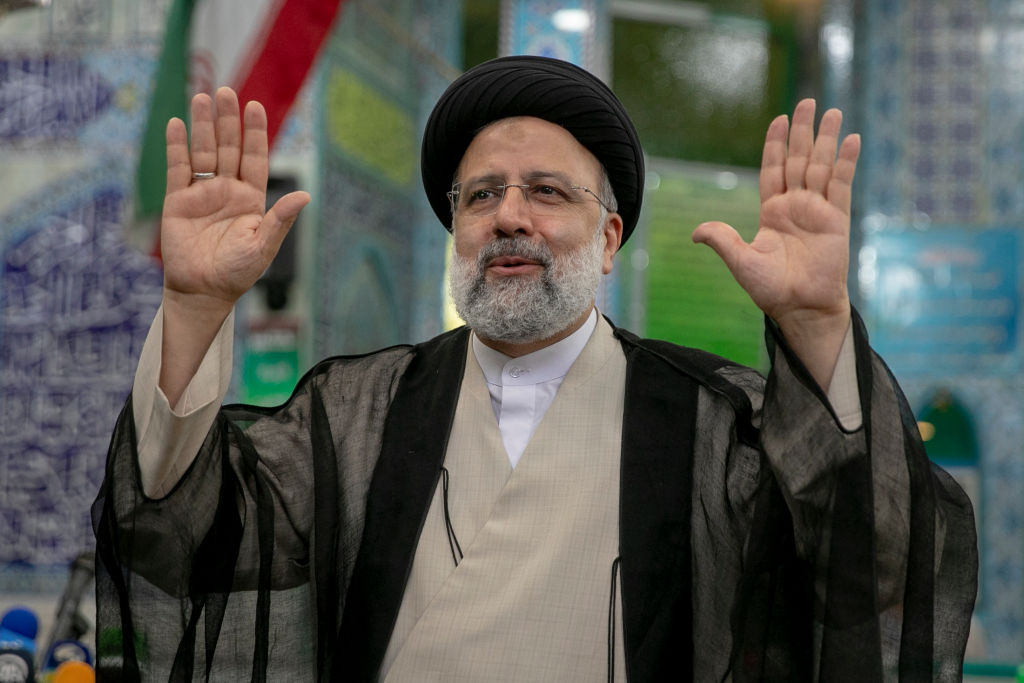
As was widely predicted, Ebrahim Raisi, a hardline conservative, won last Friday’s Iranian presidential election in a landslide and will succeed Hassan Rouhani as president in August. However, the historically low turnout of voters and highest ever informal vote clearly demonstrated Raisi’s low public appeal and serious disillusionment with the regime’s policies.
Although the Guardian Council approved seven candidates to contest the election, only four did so. Like Raisi, two of them were conservatives: Mohsen Rezaei, a former commander of the Islamic Revolutionary Guard Corps; and the first deputy speaker of the parliament, Amir-Hossein Ghazizadeh Hashemi. The sole reformist was Abdolnaser Hemmati, who until recently was governor of Iran’s central bank. The other three approved candidates, two conservatives and one reformist, withdrew shortly before election day. This is a common tactic to avoid splitting the vote among like-minded candidates or avoid an embarrassing defeat.
Although Raisi was the clear winner, the votes tell the story. According to available statistics, of Iran’s 59 million eligible voters, only 28.5 million, or some 48%, voted, the lowest percentage ever. And in Tehran, only 26% voted.
However, 3.7 million votes were declared void, the highest number ever. In effect, only 24.7 million valid votes were cast, representing about 42% of eligible voters.
While a low turnout of voters was widely predicted, the high number of invalid votes, most of which are thought to have been deliberate, was not. Together, they can be seen as protests by a majority of the people about the limited number of approved candidates and the regime’s policies generally.
Against this background, Raisi comfortably won the election, receiving 17.9 million votes, or some 63% of all votes cast. Razaei received 3.4 million, or about 12%; Hemmati, 2.4 million, or about 8%; and Hashemi, less than 1 million, or 3.5%. There are two notable factors here: Raisi received fewer votes than when he challenged Rouhani in 2017 and, in another first, the number of invalid ballots exceeded the number of votes received by each of the three losing candidates.
The election’s outcome fulfils Supreme Leader Ali Khamenei’s intent that Raisi be the next president, and that Iran return to a conservative-led government. It also gives Raisi the opportunity to demonstrate his potential as Khamenei’s successor.
However, the voting shows that Raisi doesn’t have popular appeal as a national leader. This is no surprise, particularly given his track record on human rights and presumed resistance to any social liberalisation that would clash with his traditional Islamic views.
Once in office, Raisi’s biggest challenge will be the economy. This will include resuming oil sales, restoring investment, lowering inflation and unemployment, and fighting corruption. The most significant means of reversing the current economic crisis is through the US rejoining the Joint Comprehensive Plan of Action (JCPOA), or nuclear agreement, and lifting the economic sanctions it has placed on Iran.
If Iran and the US can agree to restore the agreement before Raisi takes office, he should reap the economic benefits. If such an agreement isn’t reached before then, it would be in Raisi’s interests to act pragmatically to reach an ‘acceptable’ deal as soon as possible.
There’s some speculation that both Iran and US would prefer to conclude a deal with Rouhani rather than Raisi. A deal with Rouhani would enable him to leave the presidency on a high note. Raisi would then inherit and be under an obligation to comply with the conditions of that deal. Compliance will be important; any breach would likely cause the US to reimpose sanctions.
One significant hurdle that Raisi will face is the domestic and international implications of his human rights record. He is currently subject to human rights sanctions by both the US and European Union, and it remains to be seen how they will establish a functional working relationship with him on bilateral, multilateral and other regional security issues.
Most regional countries, including the United Arab Emirates and Qatar, have congratulated Raisi on his win and expressed their hopes for a constructive working relationship. Other players, however, will muddy the waters. Israel strongly condemned Raisi as a dangerous extremist and restated its opposition to restoring the JCPOA. Both Amnesty International and Human Rights Watch have also called for Raisi’s alleged human rights abuses to be investigated.
While Raisi’s broader views on foreign policy will become clear in the coming months, some insights emerged during his first post-election press conference, held in Tehran on 21 June. The president-elect confirmed his support for restoring the JCPOA, but also emphasised his commitment to existing Iranian policy that rejects allowing missiles and Iran’s regional activities to be part of the deal. On relations with the US, he said he supported ‘negotiations that guarantee our national interests’, but ruled out any direct meeting with US President Joe Biden in the foreseeable future. Raisi also said that one of his foreign policy priorities was to improve relations with the Gulf states generally and to re-establish diplomatic relations with Saudi Arabia.
It’s too early to make predictions on the road ahead, but given the multiple challenges, it’s certain to be a bumpy ride. Internationally, much will depend on who Raisi appoints as his foreign minister, and on how easy—or not—it will be to engage with him.

